First look: Universal Studios Hollywood powers up with Super Nintendo World
In 1981 Shigeru Miyamoto created a video game character whose entire personality was contained in what the designer first described as “16 dots by 16 dots.”
As that character evolved, those pixels would comprise red suspenders, a pouch of a tummy, an oversize nose, a bushy mustache and eventually a whole lot of jumpy pluckiness, making him an unlikely but confident hero as he sought to rescue a damsel in distress. Miyamoto at first called him Mr. Video, a prescient and self-assured designation for a character who by 1985 would come to dominate home television screens.
It wasn’t long before Mr. Video transitioned into Mario, the most recognizable video game character ever created. Mario would become so popular that Miyamoto would look to the Walt Disney Co. and its brand management of Mickey Mouse for direction. “Mickey Mouse sort of grew and evolved alongside cartoons and animation. I felt it would be best for Mario to grow and evolve alongside video games. Whenever we introduced new technology, we always paired that introduction with a new Mario game,” Miyamoto once told The Times.
Today, Mickey Mouse ears are a global symbol for theme parks around the globe. Could Mario’s trademark red newsboy-like cap challenge that dominance? Maybe, but that’s not the bet driving Universal Studios to build multiple Nintendo-inspired lands in its theme parks.
“I think it’s very clear,” says Jon Corfino, vice president at Universal Creative, the division of the company responsible for theme park experiences. “It means that entertainment is not static.”
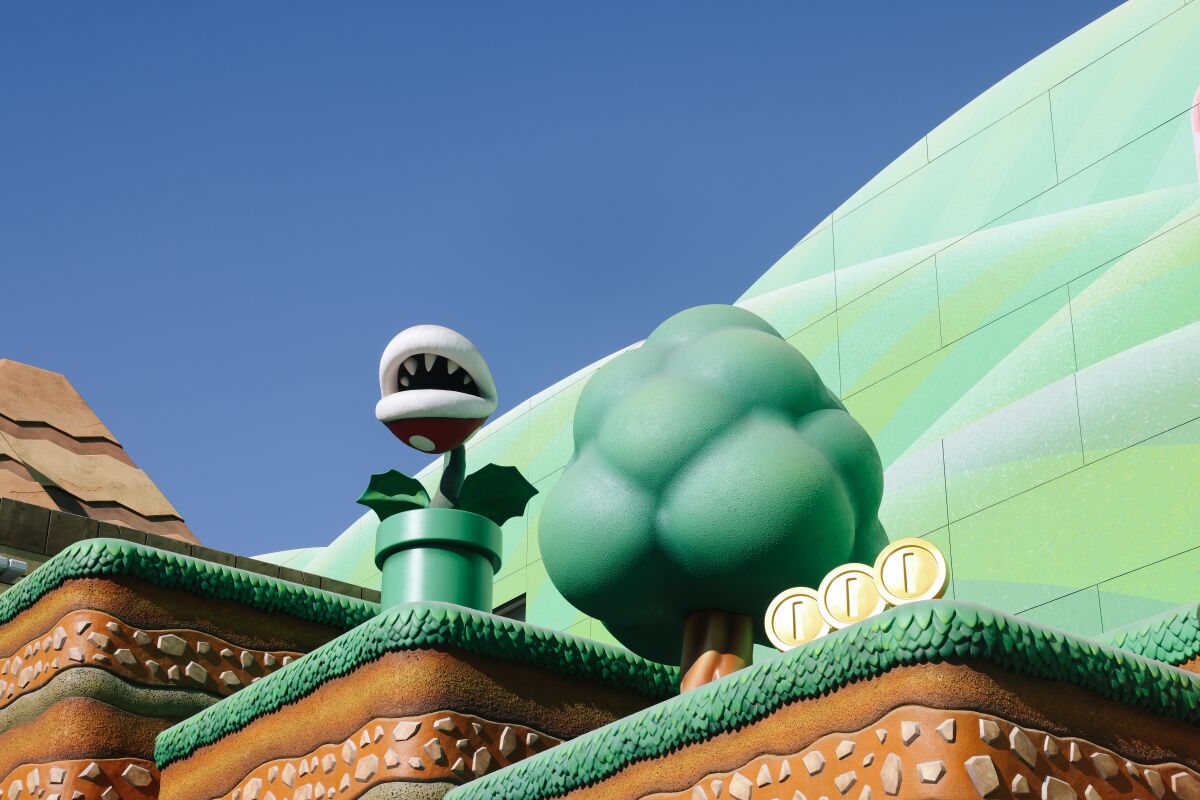
Super Nintendo World at Universal Studios is blazingly bright and colorful.
(Dania Maxwell / Los Angeles Times)
The colorful ground where Corfino is standing in Universal Studios Hollywood was once home to blocky soundstages. Today, his feet are planted on an oversize yellow star in a space dedicated to Super Nintendo World, the first major video-game-driven land in a United States theme park.
It’s a historical and remarkable shift for a park that has long stood as a temple dedicated to cinema. For nearly six decades now, the backlot Studio Tour has provided fans, tourists and aspiring filmmakers with their first notable glimpse at behind-the-scenes studio magic — the haunted imagery of a Bates Motel, the thrill of a “Jaws”-like shark attack or the ability to imagine the “Back to the Future” clock tower being shocked to life with a lightning bolt.
But on Feb. 17 when Super Nintendo World officially opens to the public, Universal Studios will be making one of the boldest statements yet about the future of entertainment: It will be interactive. Such a belief has been driving the entirety of the theme park industry for much of the last two decades, and Super Nintendo World, a larger version of which opened last year at Universal Studios Japan, will be the most fully realized vision of a living, persistent land designed to respond to — and play with — guests.
“There is a story line behind this whole experience,” Corfino says. Guests, after walking through one of Mario’s hallmark green pipes, will find themselves in the castle of his beloved Princess Peach, who has just had her golden mushroom stolen. “Part of our mission is to help her get it back. That’s the rationale and the purpose behind a lot of the interactive games.”
And with the land, Mario again will be introducing players — now theme park guests — to a new technology.
Mario Kart: Bowser’s Challenge, the land’s sole ride, will, in a first for an American theme park, meld physical sets with movement-tracking augmented reality that will respond to guest positions. It’s part old-school, theme park dark ride — guests will board cars and follow a track — and part showcase for a new form of game playing.
Guests will be asked to steer, throw and aim along a predetermined path. The attraction, one that prioritizes gamification, special effects and theme park wizardry over high-speed thrills, will place attendees, four to a car, alongside Mario, Luigi, Princess Peach and a host of other recognizable Nintendo characters, all in a highly participatory racing challenge against the demonic, turtle-meets-dragon figure of Bowser, Mario’s longtime archnemesis.
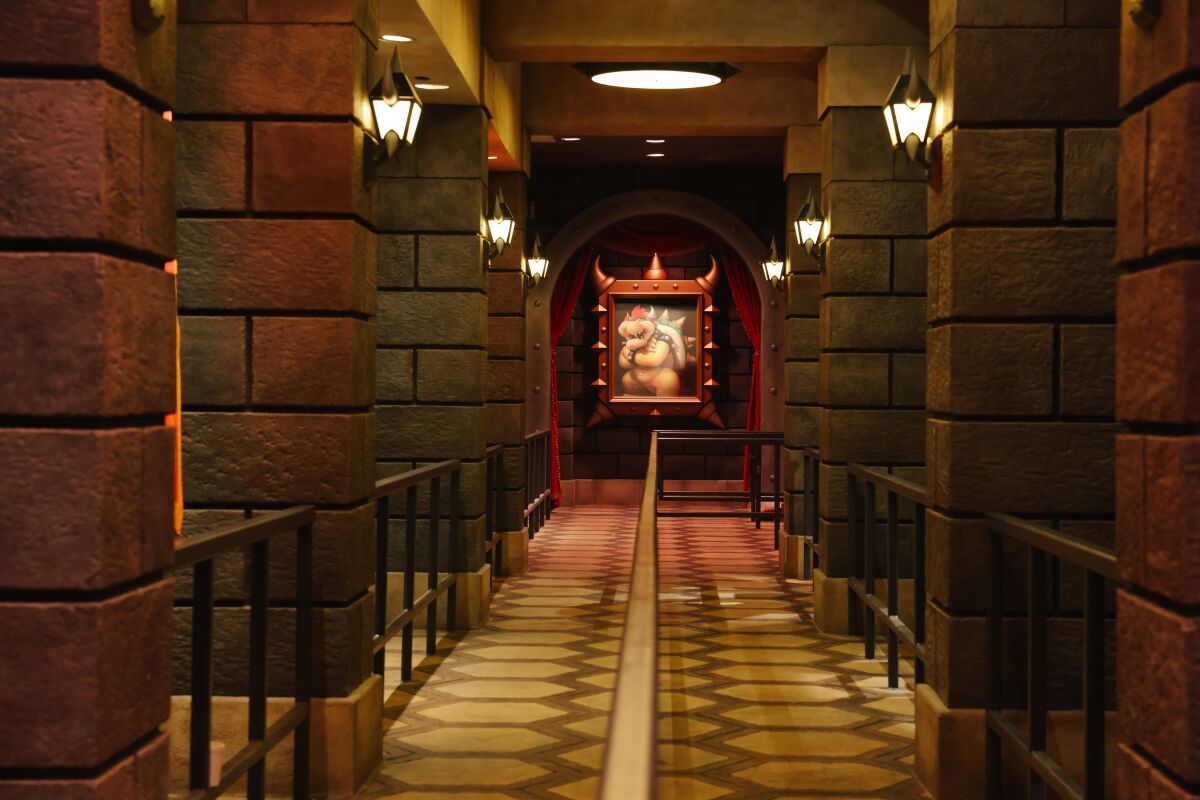
The queue for Mario Kart: Bowser’s Challenge is ominous in scope and filled with game-inspired details.
(Dania Maxwell / Los Angeles Times)
To get to the ride, visitors will first traverse a blazingly vibrant land that will mash up multiple scenes from the popular “Super Mario Bros.” games. One can gaze out of augmented-reality-enhanced telescopes near icy peaks with blue, snow-lined trees or stand below desert vistas in which a Pokey — a cactus-inspired centipede-like creature — stalks from above. Throughout, there is constant movement — Piranha Plants chomp, a stony Thwomp slams with force, and yellow blocks, ripe for punching — or ill-advised head-butting — dot what feels like a lifesize obstacle course.
Gold coins, forever out of reach, spin and glint in the SoCal sun as bouncy-looking mushrooms look eager to be jumped upon. We won’t, however, be able to run and hop through the land like Mario, but we’ll certainly feel like we should; as side-scrolling platforms tempt us to go higher, the turtle-like Koopas will walk back and forth around us, and the mushroom-inspired Goombas will wobble, stack and practically taunt us to pounce on them. But good news: We will be able to play, as dotted throughout the land are four multiplayer challenges — mini-games that will culminate in a group battle against Bowser Jr.
If all goes as planned, Super Nintendo World will be the most participatory theme park universe ever envisioned.
“They could have made Super Nintendo World a big arcade,” says Jesse Schell, a game designer and longtime advocate for interactivity in public spaces, having worked with theme parks around the world.
“But it’s clear the mandate was that this is not going to be a place where you go to play video games. This is a place where you’re going to go to be in a video game.”
A LAND BUILT FOR CREATIVITY

Guests will walk through Mario’s hallmark green pipe to enter Universal Studios Hollyoood’s Super Nintendo World.
(Dania Maxwell / Los Angeles Times)
Theme parks, of course, have always been dedicated to interactive play. One can argue that a land such as Super Nintendo World — or the game-filled Star Wars: Galaxy’s Edge at Anaheim’s Disneyland Park — are rooted in this mission.
There is, as we’ve noted before, an aspect of this approach that dates back to Disneyland’s 1955 beginnings, most notably in the staged shootouts and pack mules that brought theatrics and activity to Frontierland. Tom Sawyer Island joined the latter in 1956, allowing guests to run free amid caves, trails and a suspension bridge. The change, however, is how guests are viewed. We were once seen largely as audience members. Today, we’re essentially actors in giant playsets; that is, if we want to be.
A pivotal moment: The 2014 introduction of interactive wands at Universal’s first Wizarding World of Harry Potter, which turned the entire land into a living universe by giving players the illusion of magic-making abilities. Instead of wands, Universal hopes Super Nintendo World guests invest in Power-Up Bands, interactive wristbands available for $40.
The bands will connect with an app, which will allow guests to track their progress in recapturing the golden mushroom, as well as allow them to collect virtual coins throughout the land and keep tally of their Mario Kart ride scores. Corfino says characters in the land — Mario, his brother Luigi and Princess Peach — will be able to respond to guests based on the progress recorded by their bands. More important, the bands and app will prod guests to play the games that dot Super Nintendo World, which will be broad in scope. Most of the games require participation among multiple parties of guests. Some are timed challenges, others are crank-led puzzles, and one is a chaotic, touch-fueled game that has players turning over digital blocks.
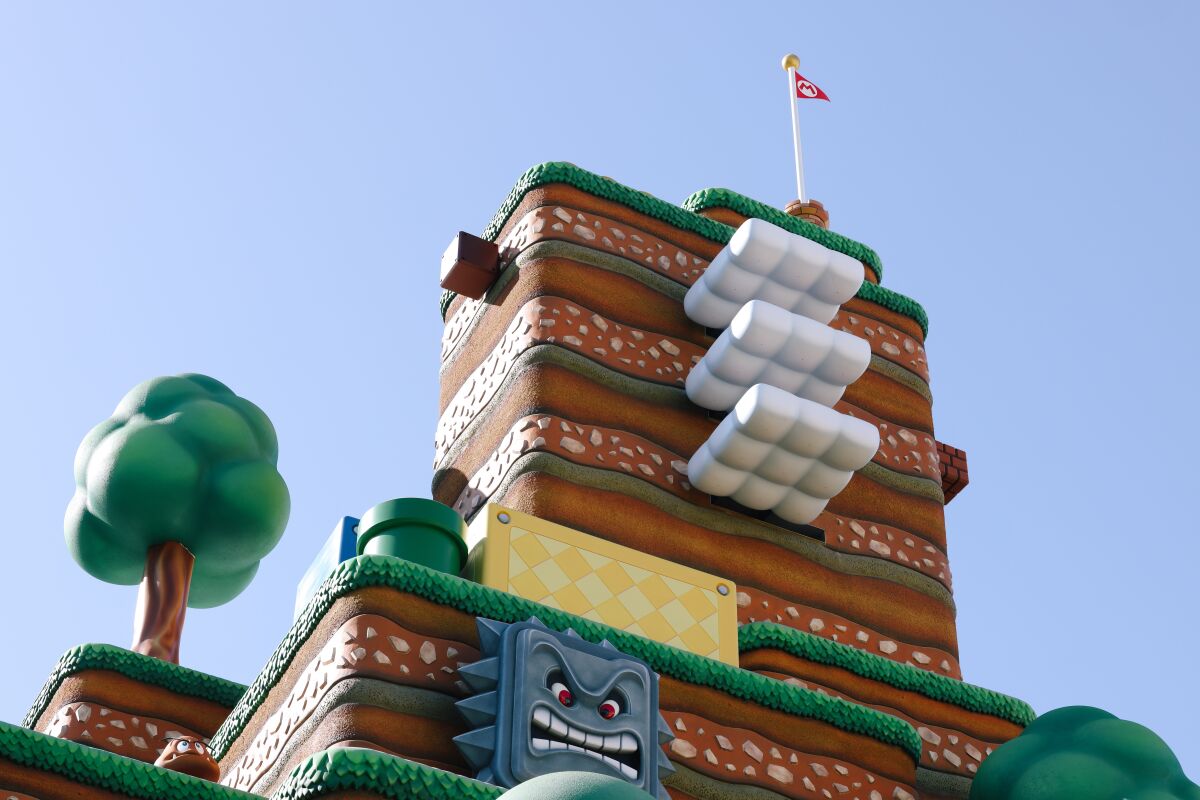
Super Nintendo World is full of movement, with blocks pouncing, characters walking and platforms sliding back and forth.
(Dania Maxwell / Los Angeles Times)
“My definition of games is maybe a little bit different,” Corfino says. “I know that some folks like to say if somehow the experience is keeping score, it’s a game. There are other attractions that have, on a one-dimensional level, kept score. But from a complete immersive aspect, everything that you’re doing here is being tied into your Power-Up Band. Then, delving into the reality of the Mario Kart ride experience, where you have AR goggles, physical sets, video mapping, LED projection — you are in a full-blown game that is unique every time based on what you’re doing. It’s pretty next level.”
The theme park industry will be watching.
“I think that this idea of being able to manifest the digital to the physical in a highly interactive, reactive social environment, which embraces a sense of agency, as well as a sense of urgency, is something where I’m seeing the future of theme parks and gaming colliding,” says Margaret Kerrison, author of “Immersive Storytelling for Real and Imagined Worlds” and a former theme park designer with Walt Disney Imagineering.
Kerrison, who worked extensively on Galaxy’s Edge, sees gaming and theme parks continuing to converge “into something that blurs the boundaries between what you do at home versus what you do in a theme park.”
The blending of theme parks and video games hasn’t always been an easy challenge to solve. Games, after all, are individualized experiences, as even multiplayer ones respond to a singular player’s actions. Theme parks, of course, are not that, as attractions are designed to captivate multiple thousands of people per hour. And yet modern attractions are increasingly gamified. The Disneyland Resort has recently opened the arcade-inspired Millennium Falcon: Smugglers Run and Web Slingers: A Spider-Man Adventure, the latter of which turns our hands into a video game controller.
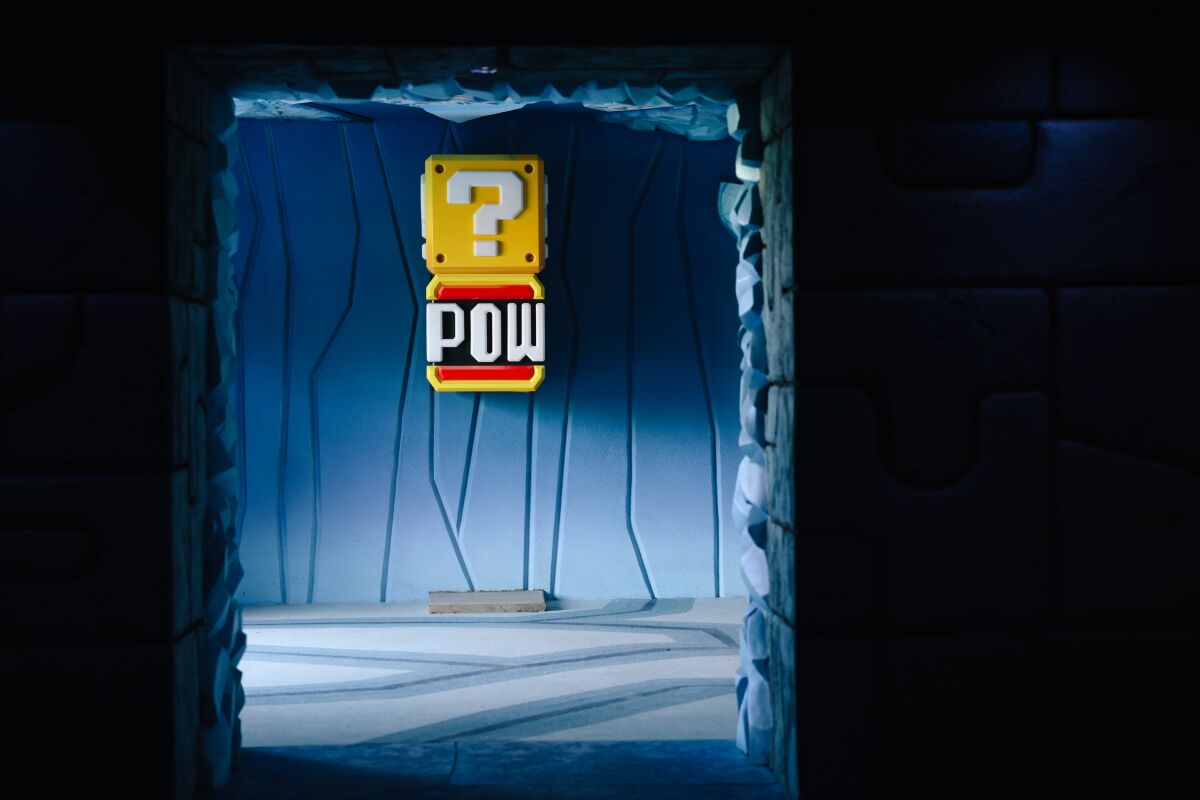
Universal Studios Hollywood’s Super Nintendo World is filled with hidden nooks for guests to discover — and play in.
(Dania Maxwell / Los Angeles Times)
Universal Studios in Florida just launched the Great Movie Escape at its City Walk, escape rooms themed to “Back to the Future” and “Jurassic Park.” This follows Walt Disney World’s Star Wars: Galactic Starcruiser, a live-in hotel that doubles as a live-action role-playing game. Play can be derided as silly or frivolous, but it also facilitates curiosity. What is that? Why is it this way? And most important: What if I try this? And in a theme park setting, that drives communication among friends, families and even strangers, as play helps lower inhibitions in the name of engagement.
That is, if we believe it.
One of the first major successful implications of video games in a theme park attraction was Disney’s Toy Story Midway Mania!, which opened at Disney California Adventure in 2008. A key to its successes, says recently retired Imagineer Kevin Rafferty, one of the chief designers of the attraction, was to rethink how we view games in all-encompassing, physical settings. “The early video games that you played on your TV set at home always had a score or a number that would flash up,” Rafferty says. “But in a ride-through application, what that does is suddenly tell you it’s fake.
“It’s not a real space. It’s not a real midway game. In a real space, you wouldn’t have digital numbers pop up like you would in a pinball machine. We wanted the experience to feel real. I always like to say it’s OK to make-believe. But you can’t fake-believe. As soon as you break the rule that you’re in a real place in a real time, then suddenly it’s not a real game booth.”
Similarly, Super Nintendo World will treat its mini-games — and its Mario Kart ride — as real places. Games are around a corner, down a path or behind a giant mushroom rather than any particular booth announcing their presence. And the land is filled with hidden nooks — stairs that lead to a second level with augmented reality googles, or darkened, seemingly ominous caves filled instead with blocks to punch and whack.
It’s a land, like the best “Super Mario Bros.” games, built on discovery. And that, after all, was Miyamoto’s original mission with the games. Asked once for an explanation for the enduring power of Mario, Miyamoto had a simple yet ambitious answer: “The more creative the player is, the more things that they try, the more fun the game becomes.”
INSIDE THE CASTLE
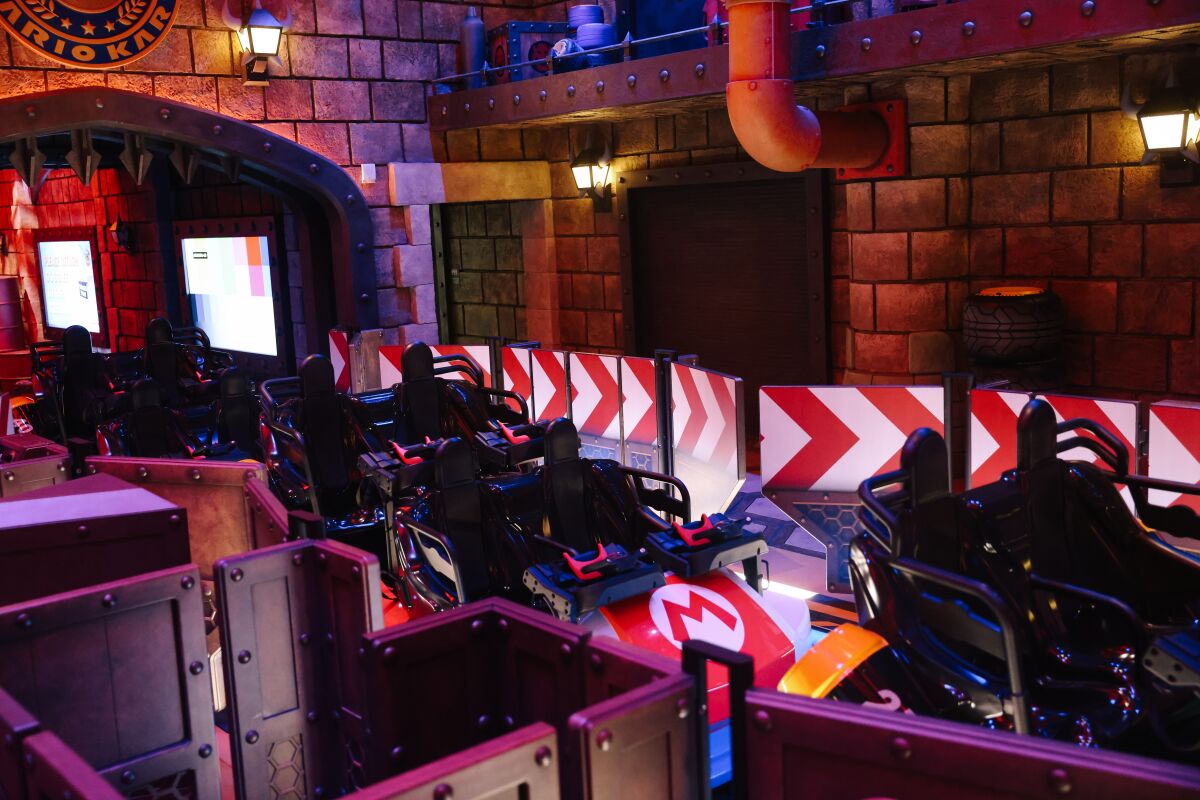
Mario Kart: Bowser’s Challenge is a first for a theme park attraction in North America — an augmented reality-enhanced game-inspired ride.
(Dania Maxwell/Los Angeles Times)
Universal Studios is counting on players coming to be creative.
Unlike Japan’s version of the land, which is home to a ride inspired by Mario’s dinosaur-like pal Yoshi and has a Donkey Kong attraction currently under construction, Hollywood’s more confined space — this theme park, after all, is still a working studio — will have just a singular ride. But those who come to ride Mario Kart and bolt will be missing the point. Super Nintendo World is an invitation to play.
And yet the byzantine queue for Mario Kart: Bowser’s Challenge certainly indicates that Universal knows what the centerpiece of the land is. The line will take guests through numerous locales, starting with fantastical, forest-like atmospheres — said to be Yoshi’s new island — before transitioning to a second level that leads to Bowser’s castle. Nintendo fans will find numerous nods to the Mario Kart games, still one of Nintendo’s most successful properties. The recent “Mario Kart 8” for the Nintendo Switch has sold more than 48 million copies worldwide.
Screens will double as windows, showing us areas of the castle populated with ghosts. Elsewhere, we’ll see Bob-omb-making machines and we’ll learn of Bowser’s obsessions — mainly Mario and Princess Peach. Self-help books, such as one titled “How to Talk to Princesses,” will nod to the roots of franchise, but in this world Princess Peach is not an oft-kidnapped, damsel-in-distress. “It’s there,” Corfino says of Bowser’s obsession with Princess Peach, “but it’s not a creepy there.”
The ride was not available for media previews. Like most of Universal’s theme park experiences, expect open-to-the-public technical rehearsals for the land to begin well before opening, perhaps as soon as early to mid-January. These, however, can be sporadic and can close at any time. But based on videos of the ride from Japan, as well as interviews and reviews of the attraction, guests should expect Mario Kart to be one of the most ambitious video-game-inspired rides to date. It’s not one, however, that prioritizes speed, as capturing the feel of the games — the wildness of collecting and flinging items and constant turns — was the goal.
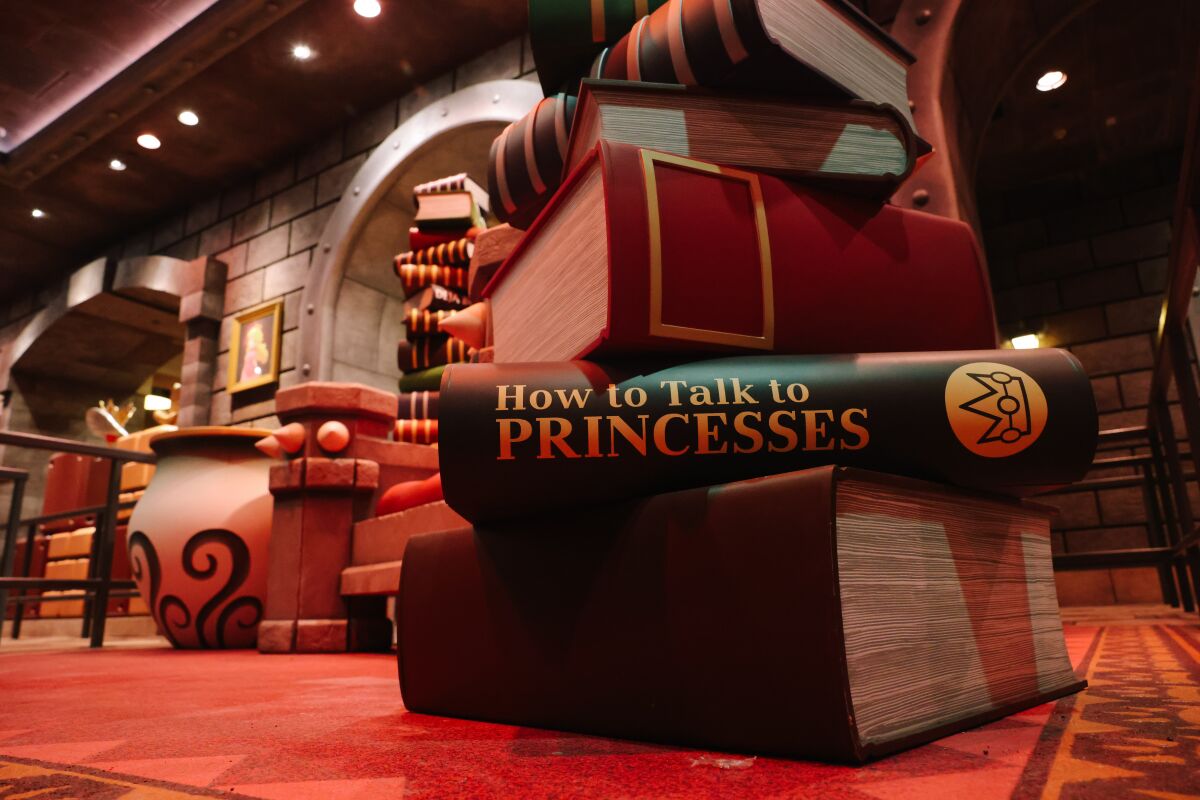
Bowser’s obsessions are shown throughout the ride Mario Kart: Bowser’s Challenge at Super Nintendo World at Universal Studios Hollywood.
(Dania Maxwell/Los Angeles Times)
“There is a learning curve,” says Corfino, noting that the mechanics are simple — press a button on a steering wheel to toss a shell and aim simply by looking in a certain direction — but mastery will come in time. While there is a track, it’s beneficial to one’s final score to steer in the direction the ride is moving, as the attraction will be asking for guests to fully participate throughout. “It’s a natural extension of evolving from behind the scenes to the immersive environments of films,” Corfino says. “So now we’re putting you inside one of the most popular games of all time and putting you inside that environment. How deep can you go in terms of immersion and, in this case, gamification?”
That’s a question that isn’t just being asked by Universal. Arguably, gaming brands — intellectual property, or IP, in industry speak — are just hitting their mainstream culture stride. In spring, Universal will release a “Super Mario Bros.” film, and gaming properties, including “The Last of Us,” “League of Legends” and “Sonic the Hedgehog,” are increasingly being adopted by Hollywood studios. The industry is also closely watching Netflix’s foray into gaming, as the company has been buying and building a cadre of game developers.
“It’s going to be interesting, as time moves on, to see which IPs end up being really meaningful,” says game and theme park designer Schell. “We see our theme parks moving into a more interactive zone. That implies that video games and video game brands are going to be bigger and bigger. It’s easy to imagine a ‘Fortnite’ theme park.”
Theme parks such as Universal Studios and Disneyland are places the public goes to experience popular myths, from classic fairy tales to more modern franchises such as “Star Wars” or “Jurassic Park.” We get to live in and among them, and experience the stories that help us make sense of the world and our emotions.
With “Super Nintendo World,” games — and play itself — have now entered a new storytelling pantheon. It’s a statement that those weaned on games have long known. We don’t play to win or compete; we play to imagine ourselves in a story.
For all the latest Entertainment News Click Here
For the latest news and updates, follow us on Google News.
